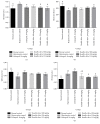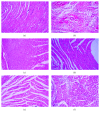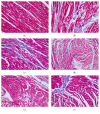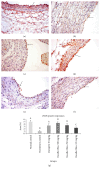Antihypertensive Effects of Roselle-Olive Combination in L-NAME-Induced Hypertensive Rats
- PMID: 29201276
- PMCID: PMC5671754
- DOI: 10.1155/2017/9460653
Antihypertensive Effects of Roselle-Olive Combination in L-NAME-Induced Hypertensive Rats
Abstract
This study aimed to evaluate the antihypertensive efficacy of a new combination therapy of Hibiscus sabdariffa and Olea europaea extracts (2 : 1; Roselle-Olive), using N(G)-nitro-L-arginine-methyl ester- (L-NAME-) induced hypertensive model. Rats received L-NAME (50 mg/kg/day, orally) for 4 weeks. Concurrent treatment with Roselle-Olive (500, 250, and 125 mg/kg/day for 4 weeks) resulted in a dose-dependent decrease in both systolic and diastolic blood pressure, reversed the L-NAME-induced suppression in serum nitric oxide (NO), and improved liver and kidney markers, lipid profile, and oxidative status. Furthermore, Roselle-Olive significantly lowered the elevated angiotensin-converting enzyme activity (ACE) and showed a marked genoprotective effect against oxidative DNA damage in hypertensive rats. Roselle-Olive ameliorated kidney and heart lesions and reduced aortic media thickness. Real-time PCR and immunohistochemistry showed an enhanced endothelial nitric oxide synthase (eNOS) gene and protein expression in both heart and kidney of Roselle-Olive-treated rats. To conclude, our data revealed that Roselle-Olive is an effective combination in which H. sabdariffa and O. europaea synergistically act to control hypertension. These effects are likely to be mediated by antioxidant and genoprotective actions, ACE inhibition, and eNOS upregulation by Roselle-Olive constituents. These findings provide evidences that Roselle-Olive combination affords efficient antihypertensive effect with a broad end-organ protective influence.
Figures













Similar articles
-
Synergistic Antihypertensive Effect of Carthamus tinctorius L. Extract and Captopril in L-NAME-Induced Hypertensive Rats via Restoration of eNOS and AT₁R Expression.Nutrients. 2016 Feb 29;8(3):122. doi: 10.3390/nu8030122. Nutrients. 2016. PMID: 26938552 Free PMC article.
-
Renoprotective and antihypertensive mechanism of action of Clinacanthus nutans bioactive polysaccharides by suppression of reactive oxygen species/ nuclear factor/ matrix metalloproteinase (ROS/NF-ΚB/MMP-9) and upregulation of endothelial nitric oxide synthase/nitric oxide (eNOS/NO) pathways.J Mol Histol. 2025 Jun 28;56(4):209. doi: 10.1007/s10735-025-10481-9. J Mol Histol. 2025. PMID: 40580398
-
Blood pressure lowering effect of an olive leaf extract (Olea europaea) in L-NAME induced hypertension in rats.Arzneimittelforschung. 2002;52(11):797-802. doi: 10.1055/s-0031-1299970. Arzneimittelforschung. 2002. PMID: 12489249
-
Current insights and future perspectives of flavonoids: A promising antihypertensive approach.Phytother Res. 2024 Jun;38(6):3146-3168. doi: 10.1002/ptr.8199. Epub 2024 Apr 14. Phytother Res. 2024. PMID: 38616386 Review.
-
A review on phytochemistry and therapeutic uses of Hibiscus sabdariffa L.Biomed Pharmacother. 2018 Jun;102:575-586. doi: 10.1016/j.biopha.2018.03.023. Epub 2018 Apr 5. Biomed Pharmacother. 2018. PMID: 29597091 Review.
Cited by
-
Protective potential of curcumin in L-NAME-induced hypertensive rat model: AT1R, mitochondrial DNA synergy.Int J Physiol Pathophysiol Pharmacol. 2020 Oct 15;12(5):134-146. eCollection 2020. Int J Physiol Pathophysiol Pharmacol. 2020. PMID: 33224436 Free PMC article.
-
The Effect of Chronic NO Synthase Inhibition on the Vasoactive and Structural Properties of Thoracic Aorta, NO Synthase Activity, and Oxidative Stress Biomarkers in Young SHR.Oxid Med Cell Longev. 2018 Jun 28;2018:2502843. doi: 10.1155/2018/2502843. eCollection 2018. Oxid Med Cell Longev. 2018. PMID: 30050647 Free PMC article.
-
Preclinical Evaluation of the Antihypertensive Effect of an Aqueous Extract of Anogeissus leiocarpa (DC) Guill et Perr. Bark of Trunk in L-NAME-Induced Hypertensive Rat.J Exp Pharmacol. 2021 Aug 7;13:739-754. doi: 10.2147/JEP.S319787. eCollection 2021. J Exp Pharmacol. 2021. PMID: 34393522 Free PMC article.
-
Immunomodulatory and Mechanistic Considerations of Hibiscus sabdariffa (HS) in Dysfunctional Immune Responses: A Systematic Review.Front Immunol. 2021 May 10;12:550670. doi: 10.3389/fimmu.2021.550670. eCollection 2021. Front Immunol. 2021. PMID: 34040600 Free PMC article.
-
Antihypertensive Effects of the Vitex cienkowskii (Verbenaceae) Stem-Bark Extract on L-NAME-Induced Hypertensive Rats.Evid Based Complement Alternat Med. 2021 Mar 5;2021:6668919. doi: 10.1155/2021/6668919. eCollection 2021. Evid Based Complement Alternat Med. 2021. PMID: 33747111 Free PMC article.
References
-
- Jing P., Qian B., He Y., et al. Screening milk-derived antihypertensive peptides using quantitative structure activity relationship (QSAR) modelling and in vitro/in vivo studies on their bioactivity. International Dairy Journal. 2014;35(1):95–101. doi: 10.1016/j.idairyj.2013.10.009. - DOI
MeSH terms
Substances
LinkOut - more resources
Full Text Sources
Other Literature Sources
Medical
Miscellaneous

